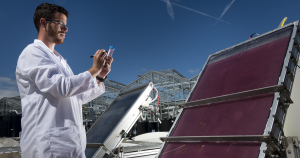Capacités develops an enzyme for biotech company DNA Script
Sourcing, modeling and high-throughput screening of DNA synthesis enzymes
Key words
Linked expertises
The acetyl functions of hyaluronic acid are usually removed through a chemical treatment. However, such poorly controlled reaction usually damages the polymer, leading to a loss of its physicochemical properties. Capacités’ experts were in charge of developing an enzymatic process to deacetylate hyaluronic acid under mild condition, in order to retain its properties.
The customer had identified an enzyme capable of replacing the known chemical process that produces a deacetylated form of hyaluronic acid. The company needed to compare this enzyme to another that possessed the desired characteristics but already patented.
Capacités’ experts first made 3D models of these two enzymes to compare their structures. The models showed strong similarities.
However, they also revealed that the active site of the enzyme selected by the customer requires modifications so as interacts more efficiently with hyaluronic acid.
Next, the enzyme engineering experts proposed directed evolution strategies for modifying the enzyme’s active site. They used the same digital models as the ones used initially to predict DNA sequence modifications for the enzyme.
Capacités’ expert succeeded in producing an enzyme having new characteristics which complies with customer specifications and improves the performance of the customer’s products in the field of cellular therapy.
To successfully complete this project, the Capacités’experts benefited from support and technical equipment from the UFIP laboratory (Protein Functionality and Engineering Unit), joint research unit of Université de Nantes CNRS (The French National Centre for Scientific Research).
OUR PROJECTS
These projects may also interest you

Sourcing, modeling and high-throughput screening of DNA synthesis enzymes

Lactalis Ingredients develops milk and whey-derived products to meet specific needs for people of all ages. This industrial company wanted to scientifically prove how one milk protein affects sarcopenia.

PiLeJe wanted to analyze the muscle relaxant effect of a valerian root extract in order to find new uses for this product, which until now has been primarily used for sleep and anxiety disorders.

ezCOL BV called upon experts in bioprocess engineering from Capacités to scale up the microalgal biomass production and provide the volume necessary for a clinical trial.
This site uses cookies and gives you control over what you want to enable